SEAT Leon ST (2014 – 2020) Review
SEAT Leon ST (2014 – 2020) At A Glance
The SEAT Leon ST is the Volkswagen Golf Estate’s Spanish cousin, offering an affordable blend of space and style when sold new between 2014 and 2020. It makes a compelling argument for those not wanting to add another SUV to the roads, but a large boot means there are no compromises when it comes to practicality. The Leon ST is also enjoyable to drive, while standard equipment is impressive across most of the model range. Compared with the Volkswagen, only the less prestigious SEAT badge is likely to deter potential buyers.
Although the world may seem to have gone mad for SUVs, traditional estate cars like the SEAT Leon ST offer a more efficient alternative. Add a combination of stylish looks and good value for money, and the Spanish wagon is worth a look.
Launched in 2014, the ST shares much with the regular hatchback version of the SEAT Leon. That means a wide choice of engines, plus a generous level of standard equipment once you venture beyond the thrifty entry-level versions. SEAT has done enough to make the ST stand out from the hatch. In other words, it looks like more than just a regular Leon with a bigger boot grafted on.
However, the boot does give a notable increase in space over the Leon hatchback. With the back seats in place, the Leon ST has a 200-litre advantage over the regular Leon. Dropping the rear seats swells total space to 1470 litres, meaning it can accommodate the most optimistic of flat-pack furniture purchases.
Space for passengers inside the Leon ST is generous, with enough space to carry four adults on long trips. Adding an extra person to the centre seat in the rear might produce complaints if they are more than child-sized, though.
The rest of the Leon ST’s interior includes plenty of additional storage space for family detritus. Large door pockets, cupholders in the centre console and an armrest on all but the basic S models are just some of the features. A split-level boot floor can make loading items into the rear easier, along with the naturally lower boot lip versus an SUV.
Along with competing against the lure of SUVs, the SEAT Leon ST also has a number of direct competitors. The mechanically similar Volkswagen Golf Estate comes closest, but demands a higher price for its more upmarket badge. Skoda’s Octavia estate delivers a bigger boot, but does so with more utilitarian styling.
While it may not have the largest boot in its class, the Leon ST occupies a relatively compact footprint. City driving should not be an issue with this estate, although the ST will always feel more at home out on the open road. Eating up the miles on long motorway journeys suits the Leon ST, although it can still entertain when the roads get twistier.
SEAT sells the Leon ST with a number of different engines. The 1.5-litre TSI petrol and 2.0 TDI diesel are the pick of the bunch, suiting the long-range cruising nature of the car. The diesels are also likely to be the preferred option for anyone looking to use their Leon ST for towing.
Where the Leon ST truly delivers is when it comes to costs. Compared with an equivalent Volkswagen Golf, whether new or used, the SEAT will be cheaper to buy. Add in fuel-efficient engines and generous standard specification, and the Leon ST makes a strong case for itself.
Buying a family estate does not need to break the bank, or mean a compromise on style, as the SEAT Leon ST proves.
SEAT Leon ST (2014 – 2020) handling and engines
- Engines range from 1.0 TSI 115 to 2.0 TSI 190 DSG
- Readers report Real MPG to be between 30–70 mpg
SEAT Leon ST (2014 – 2020): Handling and ride quality
Sharp styling aside, SEAT knows that the Leon ST is designed to appeal to families and practically-minded buyers. On the motorway it is stable and composed, making it well suited to being a long-distance machine.
Models fitted with engine outputs lower than 150PS have a simpler rear suspension setup, whereas more powerful models have a multi-link system. As a result, Leon STs with more than 150PS benefit from a slightly more refined ride quality, but the difference will be hard to spot for most drivers.
Making a bigger difference is the size of the wheels fitted. On FR models, which also gain stiffer sports suspension, the optional 18-inch wheels make for a slightly uncomfortable ride. Unless looks really matter, sticking with the standard 17-inch wheels is preferred for those in search of a smoother drive.
SEAT Leon ST (2014 – 2020): Engines
SEAT launched the Leon ST with a range of engines as used in the regular hatchback model. This means plenty of choice, with various petrol and diesel versions on offer.
Petrol engines include the 1.0-litre TSI and earlier 1.2-litre TSI units. These are fine for urban use, but can start to feel underwhelming on faster A-roads and motorways. The 1.5 TSI is the sweet-spot in the petrol range, delivering usable performance but not at the expense of fuel economy.
The diesel engines will suit those making longer journeys, with the 150PS and 184PS 2.0 TDI versions an attractive option. The extra shot of torque from the 184PS version will be useful for those travelling fully loaded. A smaller 1.6 TDI is also available for those wanting maximum miles per gallon.
Overall refinement from the petrol and diesel ranges is good, and buyers have a choice of manual or DSG dual-clutch automatic transmissions.
SEAT Leon ST (2014 – 2020): Safety
When introduced in 2014, the Leon ST was crash tested by Euro NCAP. SEAT was suitably proud of its new estate achieving the maximum five-star rating, demonstrating the high level of crash protection on offer.
There is a full suite of standard airbags, including one for the driver’s knees, along with traction control and stability control. Front and rear parking sensors are fitted to FR models and above, whilst later Xcellence models gain a reversing camera. Visibility is generally good, but the sensors do help when manoeuvring in tighter spaces.
A spare wheel is not standard on the Leon ST, but there is space beneath the boot floor to fit one.
SEAT Leon ST (2014 – 2020): Towing
As a moderately large estate car, the Leon ST is likely to appeal to those looking to tow caravans and other trailers. The diesel-engined versions make the most sense for towing, with the muscular 2.0-litre units particularly suited to the task.
The 150PS 2.0 TDI model has a maximum towing weight of 1800kg. A kerb weight of 1425kg allows for pulling trailers up to 1210kg, based on the accepted 85 percent rule.
| Engine | MPG | 0-62 | CO2 |
|---|---|---|---|
| 1.0 TSI 115 | 58–59 mpg | 10.1 s | 109–112 g/km |
| 1.0 TSI 115 DSG Ecomotive | 64 mpg | 9.8 s | 102 g/km |
| 1.0 TSI 115 Ecomotive | 64 mpg | 9.8 s | 102 g/km |
| 1.2 TSI 105 | 58 mpg | 10.3 s | 114 g/km |
| 1.2 TSI 105 DSG | 58 mpg | 10.3 s | 115 g/km |
| 1.2 TSI 110 | 57–58 mpg | 10.1 s | 114–116 g/km |
| 1.2 TSI 110 DSG | 57–58 mpg | 10.1 s | 112–114 g/km |
| 1.4 EcoTSI | 58 mpg | 8.2 s | 114 g/km |
| 1.4 EcoTSI 150 | 58 mpg | 8.2 s | 110–114 g/km |
| 1.4 EcoTSI 150 DSG | 57 mpg | 8.2 s | 111–117 g/km |
| 1.4 EcoTSI DSG | 57 mpg | 8.2 s | 117 g/km |
| 1.4 TSI 125 | 54 mpg | 9.4 s | 120 g/km |
| 1.4 TSI 140 | 53 mpg | 8.4 s | 122 g/km |
| 1.5 TSI 130 | 55–57 mpg | 9.5 s | 111–116 g/km |
| 1.5 TSI 150 | 53–55 mpg | 8.2 s | 117–120 g/km |
| 1.5 TSI 150 DSG | 53–54 mpg | 8.3 s | 118–120 g/km |
| 1.6 TDI 105 | 74 mpg | 11.1 s | 99 g/km |
| 1.6 TDI 105 DSG | 72 mpg | 11.0 s | 102 g/km |
| 1.6 TDI 110 | 67–79 mpg | 10.6–10.9 s | 87–106 g/km |
| 1.6 TDI 110 DSG | 69–71 mpg | 10.9 s | 102–105 g/km |
| 1.6 TDI 110 Ecomotive | 79 mpg | 10.6 s | 87 g/km |
| 1.6 TDI 115 | 64–69 mpg | 9.9–10.6 s | 108–111 g/km |
| 1.6 TDI 115 DSG | 66–71 mpg | 9.9–10.6 s | 106–112 g/km |
| 1.8 TSI | 47 mpg | 7.8 s | 137–138 g/km |
| 1.8 TSI DSG | 49 mpg | 7.7 s | 132–134 g/km |
| 2.0 TDI 150 | 64–67 mpg | 8.6–8.8 s | 106–114 g/km |
| 2.0 TDI 150 DSG | 61–64 mpg | 8.6–8.7 s | 115–120 g/km |
| 2.0 TDI 184 | 61 mpg | 7.8 s | 112–121 g/km |
| 2.0 TDI 184 DSG | 59–63 mpg | 7.8 s | 117–125 g/km |
| 2.0 TSI 190 DSG | 46 mpg | 7.3 s | 141 g/km |
Real MPG average for the SEAT Leon ST (2014 – 2020)

Real MPG was created following thousands of readers telling us that their cars could not match the official figures.
Real MPG gives real world data from drivers like you to show how much fuel a vehicle really uses.
Average performance
83%
Real MPG
30–70 mpg
MPGs submitted
488
SEAT Leon ST (2014 – 2020) interior
- Boot space is 587–1470 litres
- Euro NCAP rating of five stars
| Dimensions | |
|---|---|
| Length | 4535–4549 mm |
| Width | 1816–1975 mm |
| Height | 1436–1459 mm |
| Wheelbase | 2634–2636 mm |
SEAT Leon ST (2014 – 2020): Practicality
For anyone buying an estate car, practicality is likely to be the most important consideration. Thankfully, the SEAT Leon ST does not disappoint, offering a spacious interior and boot, but still within relatively compact dimensions.
The boot is not the biggest in class, but is still capable of holding 587 litres with the rear seats up. Fold the seats flat (using the levers just inside the boot hatch on all but S model cars) and storage space swells to 1470 litres. A Skoda Octavia has more still, but the SEAT counters by looking less workmanlike.
Space for passengers in the front and rear is generous, and the rear bench will be able to accommodate three adults on shorter journeys at least. The boot floor uses a split-level system, offering clever storage for smaller items, or expanding for big loads. All models except the base S have multiple storage cubbies throughout the cabin, plus a centre console armrest.
SEAT Leon ST (2014 – 2020): Quality and finish
Compared to premium brands, it may seem a little uninspiring, filled with acres of black plastic. Yet the components used are solid, and feel like they will last a lifetime of being poked and prodded by children.
Models above S grade are a little fancier, with leather trim being used on the steering wheel, handbrake and gear knob. These cars also benefit from extra chrome detailing throughout the cabin. Range-topping Xcellence versions feel genuinely plush, with standard leather upholstery and LED mood lighting.
SEAT Leon ST (2014 – 2020): Infotainment
The earliest versions of the Leon ST came fitted with a 5.0-inch multimedia touchscreen as standard. Later models saw this increased in size to a more substantial 8.0-inch display, but both versions are easy to use and offer similar functions.
Sitting at the top of the dashboard, the touchscreen is aided by a digital display mounted between the instrument gauges. Buttons on the steering wheel also make it easier to adjust settings on the move.
Connections for USB devices are standard on all models, whilst later cars gain full Android Auto and Apple CarPlay connectivity. Bluetooth makes it easy to connect your mobile phone, and there is an MP3-compatible CD player in the glovebox.
SEAT Leon ST (2014 – 2020) value for money
SEAT Leon ST (2014 – 2020): Prices
Fitting with SEAT’s strategy of being a more affordable alternative to the premium Volkswagen brand, pricing for the first-generation of the Leon ST is competitive. Final 2020 model-year examples begin from £20,635, gaining buyers an SE Dynamic model with a 1.0-litre TSI engine.
As an outgoing model, choices of colours and options may be limited for the Leon ST, but the price makes for something of a bargain. In comparison, the cheapest Volkswagen Golf Estate costs from £23,980, demonstrating the substantial saving the Spanish option offers.
Opting for the sportier FR version sees starting prices climb to £23,075, with a 1.5-litre TSI Evo petrol the standard engine. The FR Black Edition uses the same motor, but adds a digital dashboard and black alloy wheels, with the cost increasing to £24,285.
Topping the outgoing Leon ST range is the Xcellence model, priced from a considerable £25,675. Adding more safety kit and technology is the Xcellence Lux version, at a hefty £26,590.
SEAT dealers are likely to offer attractive deals in advance of the replacement second-generation Leon ST, so buyers should bargain hard. At the time of writing, SEAT is offering a £3,000 deposit contribution on the outgoing Leon ST, making PCP finance an attractive option.
Even with only a £750 deposit, a Leon ST FR 130 TSI would cost £355 over four years. SEAT also requires no payments to be made for the first three months.
Having been launched in 2014, there are now plenty of examples of the Leon ST on the used market. Prices start from less than £4,000 for early high-mileage cars, although many of these cars will have less desirable engine and trim combinations.
Finance payments on used versions are attractive, though. With a £500 deposit, buyers could be behind the wheel of a Leon ST 1.6 TDI for £100 a month over four years.
SEAT Leon ST (2014 – 2020): Running Costs
The tiny 1.0-litre TSI petrol engine can deliver 64mpg, whilst even the popular 1.5 TSI Evo can achieve 55mpg in more powerful 150PS form.
Diesel options will make sense for those covering longer distances, and the 110PS 1.6 TDI Ecomotive achieved almost 79mpg in official tests. The Honest John Real MPG data suggests these older (NEDC) figures for the Leon ST are broadly representative of what drivers can expect in the real world, too.
That 1.6-litre TDI version of the Leon ST is likely to hold further appeal for those wanting to save on VED (road tax) costs. Models registered before April 2017 fall inside Band A, meaning they are liable for no VED at all. Owners of cars registered after April 2017 will all pay £150 a year, with the 2.0-litre TSI petrol stung with a £540 first-year rate.
Insurance costs also suit the more budget-orientated nature of the Leon ST. The SEAT badge helps keep insurance group ratings relatively low. These start at group 12 for the 1.0-litre TSI petrol, increasing to group 27 for the 2.0-litre TDI 184PS diesel.
Satisfaction Index
 What is your car like to live with?
What is your car like to live with?
We need your help with our latest Satisfaction Index, so that we can help others make a smarter car buying decision. What's it like to live with your car? Love it? Loath it? We want to know. Let us know about your car - it will only take a few minutes and you could be helping thousands of others.
Help us with the Honest John Satisfaction Index nowSEAT Leon ST (2014 – 2020) models and specs
The SEAT Leon ST has been sold with a number of different trim options, intended to appeal to differing budgets and taste.
Entry level S models are best avoided, with 15-inch steel wheels and black roof rails giving a bargain appearance. SE versions should not cost much more, and add features like cruise control, 16-inch alloy wheels and leather trim for the steering wheel. For most drivers, the SE model should deliver what they need.
Fans of sportier looks will be drawn to the FR, which wears different bumpers and 17-inch alloy wheels. Stiffer sports suspension and dual-zone climate control are also part of the deal.
The range is topped by the Xcellence, adding almost every possible option to the Leon ST. Full LED headlights, keyless entry, leather seats and a chrome front grille are just some of the highlights.
As neat as some of these touches are, they are not worth paying a substantial premium for over the SE or FR versions.
| Dimensions | |
|---|---|
| Length | 4535–4549 mm |
| Width | 1816–1975 mm |
| Height | 1436–1459 mm |
| Wheelbase | 2634–2636 mm |
| Miscellaneous | |
|---|---|
| Kerb Weight | 1236–1435 kg |
| Boot Space | 587–1470 L |
| Warranty | 2 years / 60000 miles |
| Servicing | 10000–30000 miles |
| Spare Wheel | |||
|---|---|---|---|
| Standard | Tyre-repair kit | ||
| Alternative | Space-saving spare wheel | ||
| Costs | |
|---|---|
| List Price | £16,675–£29,975 |
| Insurance Groups | 12–26 |
| Road Tax Bands | A–F |
| Official MPG | 45.6–78.5 mpg |
| Euro NCAP Safety Ratings | |
|---|---|
| Adult | - |
| Child | - |
| Pedestrian | - |
| Overall | 5 |
On sale until December 2020
On sale until October 2019
| Estate | |||
|---|---|---|---|
| Version | List Price | MPG | 0-62 |
| Sports Tourer 1.5 TSI Evo 130 FR Sport EZ 5dr | £24,575 | 55.4 mpg | 9.5 s |
| Sports Tourer 1.5 TSI Evo 150 FR Sport EZ 5dr | £26,190 | 53.3 mpg | 8.2 s |
| Sports Tourer 1.5 TSI Evo 150 FR Sport EZ DSG 5dr | £27,540 | 53.3 mpg | 8.3 s |
| Sports Tourer 1.6 TDI 115 SE Dynamic EZ DSG 5dr | £22,665 | 68.9 mpg | 10.6 s |
| Sports Tourer 1.6 TDI 115 SE EZ DSG 5dr | £21,900 | 70.6 mpg | 10.6 s |
| Sports Tourer 2.0 TDI 150 FR Sport EZ 5dr | - | - | - |
| Sports Tourer 2.0 TDI 150 FR Sport EZ DSG 5dr | - | - | - |
| Sports Tourer 2.0 TSI 190 FR EZ DSG 5dr | £26,675 | 45.6 mpg | 7.3 s |
| Sports Tourer 2.0 TSI 190 FR Sport EZ DSG 5dr | £28,825 | 45.6 mpg | 7.3 s |
| Sports Tourer 2.0 TSI 190 Xcellence EZ DSG 5dr | £28,305 | 45.6 mpg | 7.3 s |
| Sports Tourer 2.0 TSI 190 Xcellence Lux EZ DSG 5dr | £29,130 | 45.6 mpg | 7.3 s |
On sale until February 2019
On sale until September 2017
| Estate | |||
|---|---|---|---|
| Version | List Price | MPG | 0-62 |
| Sports Tourer 2.0 TDI 150 FR Technology DSG 5dr | £25,365 | 62.8 mpg | 8.6 s |
| Sports Tourer 2.0 TDI 150 SE Dynamic Technology 5dr | £21,340 | 67.3 mpg | 8.6 s |
| Sports Tourer 2.0 TDI 150 SE Technology 5dr | £22,270 | 65.7 mpg | 8.6 s |
| Sports Tourer 2.0 TDI 150 Xcellence Technology DSG 5dr | £26,015 | 62.8 mpg | 8.6 s |
On sale until April 2017
On sale until July 2015
| Estate | |||
|---|---|---|---|
| Version | List Price | MPG | 0-62 |
| S 1.2 TSI 110 5dr | £17,110 | 57.6 mpg | 10.1 s |
| S 1.6 TDI 105 5dr | £18,810 | 74.3 mpg | 11.1 s |
| SE 1.6 TDI 105 5dr | £19,930 | 74.3 mpg | 11.1 s |
| SE 1.6 TDI 105 DSG Auto 5dr | £21,180 | 72.4 mpg | 11.0 s |
On sale until June 2014
| Estate | |||
|---|---|---|---|
| Version | List Price | MPG | 0-62 |
| FR 1.4 TSI 140 5dr | £20,390 | 53.3 mpg | 8.4 s |
| S 1.2 TSI 105 5dr | £16,675 | 57.6 mpg | 10.3 s |
| SE 1.2 TSI 105 5dr | £17,795 | 57.6 mpg | 10.3 s |
| SE 1.2 TSI 105 DSG 5dr Auto | £19,045 | 57.6 mpg | 10.3 s |
| SE 1.4 TSI 140 5dr | £18,845 | 53.3 mpg | 8.4 s |
Model History
- July 2013: SEAT unveiled the all-new Leon ST
- September 2013: Leon ST Prices announced
- October 2013: SEAT opened order books for Leon Ecomotive
- January 2015: 280PS SEAT Leon ST Cupra 280 announced
- August 2015: Leon SE Technology Business model added
- March 2019: SEAT Leon Cupra R ST announced
July 2013
SEAT unveiled the all-new Leon ST
It becomes the third member of the new Leon family, which now comprises five-door hatchback, three-door SC and five-door ST estate.
It boasts a 587-litre boot, and with the rear seats folded flat its load capacity extends to 1,470 litres.
And with the debut of the Leon ST, SEAT is expanding the extensive line-up of hi-tech options already available with the model, introducing Adaptive Cruise Control (ACC), Adaptive Chassis Control (DCC) damper adjustment, and Progressive Steering. The optional Dynamic Pack, including DCC and Progressive Steering, enables a high degree of control under sporty driving conditions.
The engine range available for the Leon ST is the same as that for the five-door and SC versions. All have Start/Stop and Energy Recovery systems, from the 1.2 TSI petrol and 1.6 TDI diesel, right up to the most powerful 1.8 TSI and 2.0 TDI units.
The 1.2 TSI 105 PS engine returns 57.6 mpg, while the state-of-the-art 1.4 TSI 140PS runs it very close, with a 53.3mpg average figure. At the top of the petrol line-up is the 1.8 TSI engine, available in FR trim only, delivering 180PS and 250Nm of torque.
The entry level diesel model is the 1.6 TDI with 105PS and a strong 250Nm of torque. The 2.0 TDI with 150PS and 320Nm of torque provides powerful propulsion, yet with the Start/Stop and Energy Recovery, it manages to emit just 106g/km CO2 and return 68.9mpg.
A sporty highlight is the 2.0 TDI with 184PS and 380Nm of torque – another FR exclusive – which achieves an awesome 65.7 miles on average per gallon of fuel used.
In the base version, the Leon ST weighs in at just 1,233 kg, making it a 45 kg heavier than the five-door Leon and the lightest estate in its class. Nevertheless, the ST offers a host of functional equipment details that significantly benefit everyday usability. The rear seat backrests are extremely easy to fold down from the luggage compartment, while the double floor makes the boot very easy to load and unload. The passenger-seat backrest can be folded over to accommodate especially long items.
September 2013
Leon ST Prices announced
Starting at £16,675, the Leon ST is £825 more than an equivalent five-door version. Every Leon ST comes with roof rails as standard, a double-floor setup in the boot, a rear reading light, and a 12V socket. In addition, a through hatch allows loading of long, thin items, while buyers can choose an optional fold-down passenger seat, for even greater load-lugging capacity.
The engine and trim range of the Leon ST is as per the five-door and SC variants, meaning an S-SE-FR hierarchy, with petrol engines ranging from the 1.2 TSI 105 PS, through the 1.4 TSI 140 PS and on to the most powerful 1.8 TSI 180 PS. On the diesel front, there are now two versions of the 1.6 TDI - a standard 105 PS variant, and the just-announced 110 PS Ecomotive. Following those are the 2.0 TDI units, with either 150 PS or 184 PS. A range of transmissions are available, from a five- or six-speed manual to a six- or seven-speed DSG automatic.
|
Trim |
Litres |
Engine |
PS |
Basic Price |
VAT @ |
Retail Price |
1st Year |
1st Reg |
Recommended On The Road |
|
20.00% |
(P11D Value) |
RFL Rate |
Fee |
Price |
|||||
|
S |
1.2 |
TSI |
105 |
£13,850.00 |
£2,770.00 |
£16,620 |
£0 |
£55 |
£16,675 |
|
S |
1.6 |
TDI |
105 |
£15,266.67 |
£3,053.33 |
£18,320 |
£0 |
£55 |
£18,375 |
|
SE |
1.2 |
TSI |
105 |
£14,783.33 |
£2,956.67 |
£17,740 |
£0 |
£55 |
£17,795 |
|
SE |
1.2 |
TSI DSG-auto |
105 |
£15,825.00 |
£3,165.00 |
£18,990 |
£0 |
£55 |
£19,045 |
|
SE |
1.4 |
TSI |
140 |
£15,658.33 |
£3,131.67 |
£18,790 |
£0 |
£55 |
£18,845 |
|
SE |
1.6 |
TDI |
105 |
£16,200.00 |
£3,240.00 |
£19,440 |
£0 |
£55 |
£19,495 |
|
SE |
1.6 |
TDI Ecomotive |
110 |
£17,025.00 |
£3,405.00 |
£20,430 |
£0 |
£55 |
£20,485 |
|
SE |
1.6 |
TDI DSG-auto |
105 |
£17,241.67 |
£3,448.33 |
£20,690 |
£0 |
£55 |
£20,745 |
|
SE |
2.0 |
TDI |
150 |
£17,325.00 |
£3,465.00 |
£20,790 |
£0 |
£55 |
£20,845 |
|
SE |
2.0 |
TDI DSG-auto |
150 |
£18,366.67 |
£3,673.33 |
£22,040 |
£0 |
£55 |
£22,095 |
|
FR |
1.4 |
TSI |
140 |
£16,945.83 |
£3,389.17 |
£20,335 |
£0 |
£55 |
£20,390 |
|
FR |
1.8 |
TSI |
180 |
£17,845.83 |
£3,569.17 |
£21,415 |
£125 |
£55 |
£21,595 |
|
FR |
1.8 |
TSI DSG-auto |
180 |
£18,887.50 |
£3,777.50 |
£22,665 |
£125 |
£55 |
£22,845 |
|
FR |
2.0 |
TDI |
150 |
£18,612.50 |
£3,722.50 |
£22,335 |
£0 |
£55 |
£22,390 |
|
FR |
2.0 |
TDI DSG-auto |
150 |
£19,654.17 |
£3,930.83 |
£23,585 |
£0 |
£55 |
£23,640 |
|
FR |
2.0 |
TDI |
184 |
£19,437.50 |
£3,887.50 |
£23,325 |
£0 |
£55 |
£23,380 |
October 2013
SEAT opened order books for Leon Ecomotive
The Leon Ecomotive ST returns 85.6mpg combined fuel consumption while 87g/km CO2 figure puts the car into VED Band A.
Power comes from a 1.6-litre TDI diesel engine, mated to a six-speed manual gearbox whose ratios are spaced for optimum efficiency; the transmission is a fundamental difference between the Leon Ecomotive and the standard Leon 1.6 TDI, which itself emits a very modest 99g/km, equipped with a five-speed manual gearbox.
January 2015
280PS SEAT Leon ST Cupra 280 announced
£28,505 (or £29,860 for DSG). UK ordering now for deliveries from march 2015.
Leon ST CUPRA 280’s two-litre turbocharged 280 PS engine gets it it from 0-62 mph in under six seconds and to a limited top speed of 155 mph.
Inside and out, the ST CUPRA 280 retains all of the Leon ST’s usual style and practicality, including its sizeable 587-litre boot, which rises to 1,470 litres with the rear seats folded at the pull of a single lever. 19-inch CUPRA alloy wheels with titanium finish, red brake callipers, rear spoiler and diffuser housing two oval end chrome tailpipes, together with substantial air intakes at the front.
August 2015
Leon SE Technology Business model added
The new model boasts a raft of equipment to support fleets and make life easier for company car drivers including a Technology Pack, adaptive cruise control, rear parking sensors and a Convenience Pack.
Like its fleet-optimised specification, the new model’s powertrain options maximise value for business drivers and fleets – particularly with the new tax regime in mind. The five-door 1.6 TDI 110PS version emits just 99 grams per kilometre of CO2 and achieves 74.3mpg on the combined cycle. Its benefit-in-kind (BIK) tax rate is 17% in five-door guise and 18% in ST format.
The Technology Pack, comprising integrated satellite navigation, DAB audio system and LED headlights, was chosen alongside adaptive cruise control and rear parking sensors for maximum comfort and safety. The Convenience Pack, consisting of automatic headlights, rain sensor and auto dimming rear view mirror, means the vehicle is easy to live with.
Initially available in capacious estate form, the SEAT Leon ST SE Technology Business is available to order in either 1.6 TDI 110PS or 2.0 TDI 150PS form, priced from £20,545 (P11D value) or £20,650 OTR. The order book for the five-door version will open in early 2016.
March 2019
SEAT Leon Cupra R ST announced
Limited edition model with just 150 being sold in the UK. Orders open in April, with prices starting from £37,975 for the 2.0 TSI with 300PS. For an extra £500, customers can upgrade to 370PS with the factory-approved ABT tuning pack, taking the 0-62mph figure down to 4.5 seconds. The standard model reaches 62mph in 4.9 seconds and a top speed of 155mph.
What to watch out for
Report of handbrake failure on 2014 Leon ST.
29-09-2021:Report of coolant leak on 2019 Leon ST. The car has just been serviced at 29,692 miles and the owner has been advised that the thermostat housing is leaking coolant. The dealer has said that they have seen this three or four times already on this model. Owner was quoted on the day that the cost would be £852. He has since had a call from the dealer to say that the replacement would actually be £978 but the manufacturer and the dealer would contribute 50 per cent, leaving him with a bill for £489.

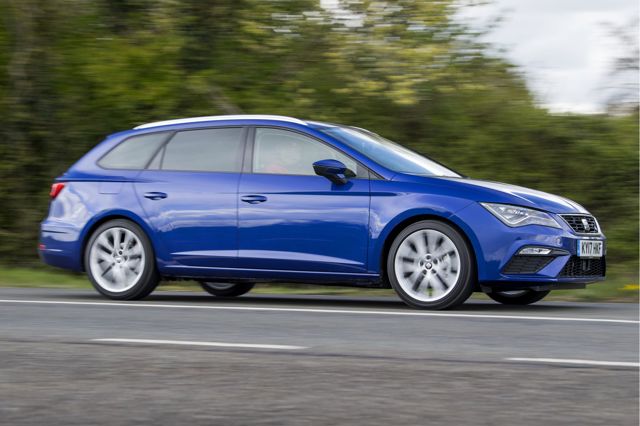
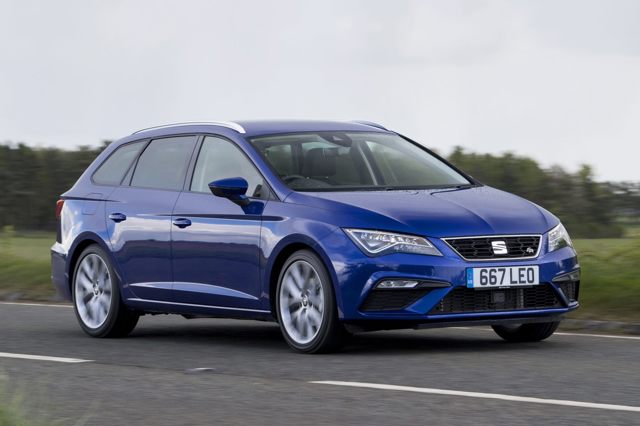
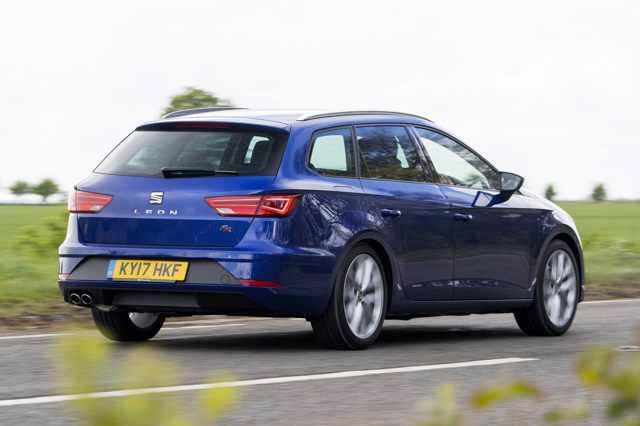
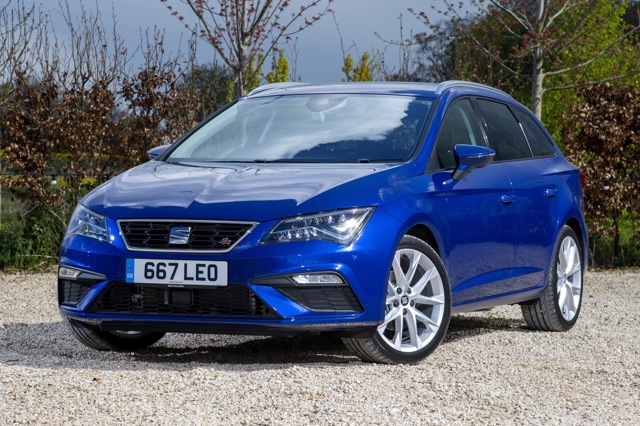
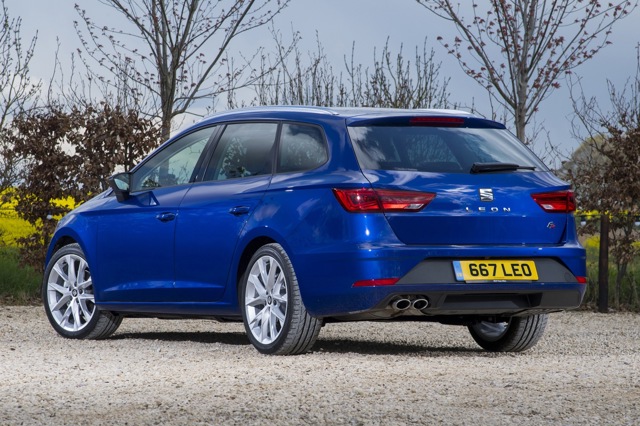
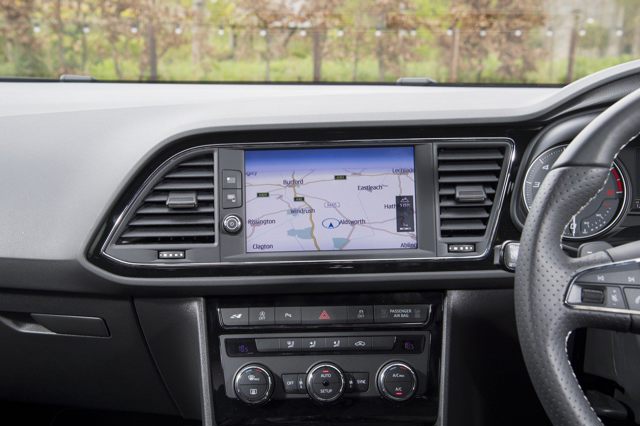
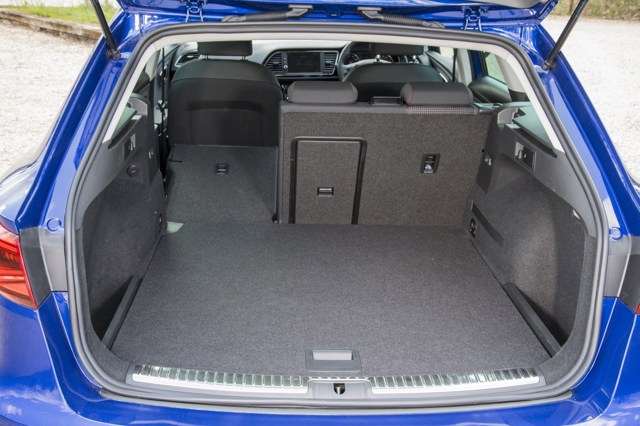


 A very stylish estate car, standard equipment is generous beyond the basic S version, compact size yet plenty of space for passengers and luggage.
A very stylish estate car, standard equipment is generous beyond the basic S version, compact size yet plenty of space for passengers and luggage.
 Ride on models with larger 18-inch wheels can be harsh, SEAT badge is less appealing than rival Volkswagen, boot slightly smaller than some estates in the same class.
Ride on models with larger 18-inch wheels can be harsh, SEAT badge is less appealing than rival Volkswagen, boot slightly smaller than some estates in the same class.
.jpg?width=240&height=160&rmode=crop)

.jpg?width=240&height=160&rmode=crop)
.jpg?width=240&height=160&rmode=crop)